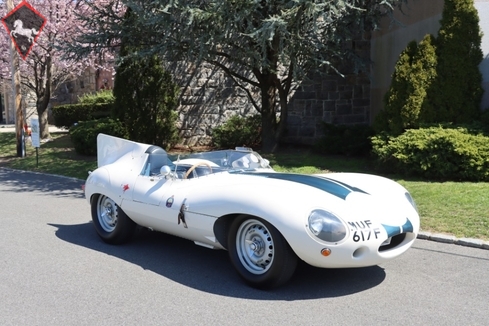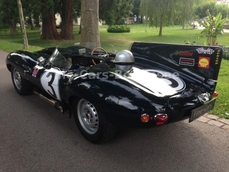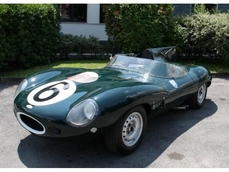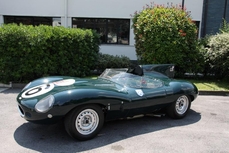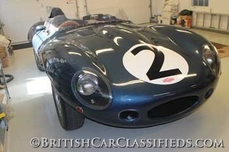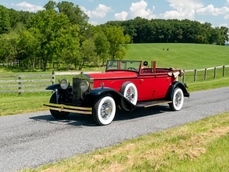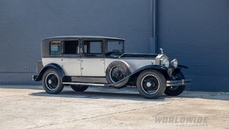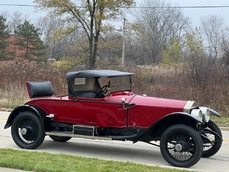Jaguar D-Type Recreation 1967
General description :
1967 Jaguar D-Type Recreation by Lnyx This Jaguar D-Type re-creation is a long-nose example that was constructed by Lynx Cars Limited of St. Leonards-on-Sea in England using handmade aluminum bodywork. The car is said to have been commissioned by former UK Jaguar club president Jerry Stampler who campaigned it in vintage racing before it was acquired through Lynx approximately 20 years ago by its pervious owner, former sports car racer Herb Wetanson. Finished in white with blue stripes over blue leather, it is powered by a 3.8-liter XK inline-six with triple Weber carburetors, a four-speed manual transmission, dual-circuit four-wheel disc brakes, independent suspension, Dunlop-style peg-drive wheels, a tail fin, a wraparound windshield, an aluminum tonneau cover, four-point harnesses, and tool kit. Lynx Engineering was founded in 1968 by engineer Guy Black and architect Roger Ludgate, and initially specialized in the repair and restoration of original Jaguar C- and D-Type sports racers. In 1972 the company began development of a D-Type replica design utilizing hand-formed aluminum bodywork and E-Type-derived mechanicals. Construction incorporated a Lynx-fabricated monocoque tub mated to modified E-Type subframes, and the cars were built in both short- and long-nose configurations. This long-nose example features an optional rear headrest fin and full-length wraparound windshield, and its bodywork wears Briggs Cunningham-style white and blue livery. The condition of the finish is shown up close in the gallery below. Details include a louvered hood with leather hold-down straps, a Monza-style fuel filler concealed within the fin, side-exit exhaust pipes, and UK registration number MUF 617F.Dunlop-style aluminum peg-drive wheels are secured by three-eared knock-offs and wear Dunlop racing tires measuring 6.00L-16 up front and 6.50L-16 at the rear. A spare is housed in the rear compartment. Twin brake master cylinders actuate discs all around, with the rears mounted inboard of the independent suspension. The split cockpit features seating for two trimmed in blue leather as well as aluminum surfaces painted to match the body stripes. Equipment includes Luke four-point harnesses, a drivers headrest, a rearview mirror, and a fire extinguisher. An aluminum tonneau cover fits over the passenger seat. A wood-rimmed steering wheel sits ahead of a black dash housing Smiths instrumentation including a 180-mph speedometer, a tachometer, and gauges monitoring coolant temperature and oil pressure. The five-digit odometer shows 21k miles, approximately 5k of which have been added by the current owner. The 3.8-liter DOHC inline-six is fed by three dual-throat Weber carburetors fitted to a Lynx intake manifold and features three-into-one exhaust headers, an alternator, an aluminum coolant header tank, an electric cooling fan, and dry sump lookalike components. An annual service in spring 2021 included adjustment of the carburetors, a coolant flush, lubrication, and replacement of the ignition points and spark plugs. An oil change was performed in summer 2021. Power is sent to the rear wheels through a four-speed manual gearbox. The E-Type-derived suspension features dual Spax coilovers at each rear wheel and a torsion-bar front setup with double wishbones and telescopic shock absorbers. The car is registered using chassis number 1E78735BW, which corresponds to a left-hand-drive 1968 E-Type 2+2. The identification tag is also stamped with Lynx body number L89 46, which is reflected on an adjacent front frame attachment plate.Chassis: 1E78735BWLong-Nose Bodywork with Tail FinTriple Weber CarburetorsFour-Speed Manual TransmissionWhite Paint with Blue StripesFull-Length Wraparound WindshieldBlue Leather Cockpit UpholsteryDunlop-Style Peg-Drive WheelsDual-Circuit Four-Wheel Disc BrakesE-Type Independent SuspensionAluminum Passenger-Side Tonneau CoverTool KitPrice: $325,000
https://www.gullwingmotorcars.com/1967-jaguar-d-type-recreation-c-4797.htm
1967 Jaguar D-Type Recreation is listed sold on ClassicDigest in Astoria by Gullwing Motor for $325000.
Car Facts
Car type : Car Make : Jaguar Model : D-Type Model Version : Recreation Engine size : 0.0 Model Year : 1967 Location : Astoria
Sold
Seller Information
Sold
People who viewed this Jaguar D-Type also viewed similar Jaguar listed at ClassicDigest
Other cars listed for sale by this dealer
About Jaguar
Ah, the story of Jaguar, from its early days as the SS Cars Ltd. to its pinnacle with the D-type, and the street-going evolution in the form of the iconic E-type. There's something quintessentially British about this tale, and I'll narrate it as a British journalist might.In the Beginnings:
Our journey into the world of Jaguar begins in the 1930s, when a company known as SS Cars Ltd. emerged. Despite the unfortunate coincidence of their initials with the rising political tensions in Europe, they started producing stylish and performance-oriented cars. The SS 100, introduced in 1936, was a symbol of elegance and speed, setting the stage for what would become Jaguar.
The Birth of Jaguar:
As the shadows of World War II loomed, SS Cars Ltd. wisely decided to disassociate themselves from the SS initials. Thus, in 1945, they officially became Jaguar Cars Ltd., a name that would soon be synonymous with British luxury and performance.
The XK Series:
Jaguar's post-war era brought us the XK 120, a true sensation in 1948. With its sleek design and a powerful 3.4-liter inline-six engine, it became the world's fastest production car. The XK 120 was the blueprint for what lay ahead – Jaguars that blended style with speed in a uniquely British fashion.
The D-type Dominance:
Then came the D-type, a true racing legend. Introduced in 1954, it won Le Mans three times in the 1950s, showcasing Jaguar's engineering prowess. With its innovative monocoque construction and the iconic fin at the back, the D-type was the apex of Jaguar's motorsport success.
The E-type Emergence:
But the true turning point arrived in 1961 with the introduction of the E-type, often described by Enzo Ferrari as "the most beautiful car ever made." Its long bonnet, curvaceous body, and a 3.8-liter engine delivering exhilarating performance made it an instant classic. The E-type was not just a car; it was a work of art on wheels, and it could hit 150 mph on the road.
Street and Racing Success:
The E-type's beauty was matched by its capability on the track. The lightweight E-types were particularly successful in various racing events, cementing Jaguar's reputation as a force to be reckoned with in motorsport.
The Age of Refinement:
As we delve deeper into the Jaguar story, we find that the 1950s and 1960s were an age of refinement and expansion. Alongside the magnificent D-type and the E-type's iconic emergence, Jaguar introduced models that further solidified its reputation for luxury and performance.
The MK2:
In the late 1950s, Jaguar unveiled the MK2, a sports sedan that combined elegance with power. This sleek four-door saloon was a favorite of bank robbers and law enforcement alike, thanks to its exceptional speed and handling. The MK2 was a symbol of Jaguar's ability to blend sophistication with performance and had a successful racing career as well.
The XJ6:
Fast forward to 1968, and Jaguar launched a car that would define luxury saloons for decades to come – the XJ6. It was a masterpiece of engineering and design, featuring a smooth inline-six engine, independent rear suspension, and a spacious, beautifully appointed interior. The XJ6 was a symbol of British elegance and provided a ride so smooth that it seemed to glide over the road. It became the flagship model for Jaguar and set the standard for luxury saloons, showcasing a level of refinement that left competitors in awe.
The Blend of Classic and Modern:
While the MK2 and XJ6 represented the evolution of Jaguar's saloon cars, they maintained the brand's commitment to performance and luxury. These cars didn't just belong on the racetrack; they were equally at home cruising down the grand boulevards or gliding through the English countryside.
The Challenges of Change:
However, as the 1970s arrived, Jaguar, like many British automakers, faced financial challenges and changes in ownership. The British Leyland era brought both opportunities and struggles, as the brand navigated through various mergers and transitions.
Nevertheless, the legacy of the MK2 and XJ6, along with the D-type and E-type, continues to define Jaguar as a manufacturer that combines timeless elegance with a spirit of performance. These classic models, whether driven on winding roads or parked as collectors' treasures, serve as a testament to Jaguar's enduring presence in the world of automotive excellence.
The Jaguar story, from its early days as SS Cars Ltd. to the creation of automotive icons like the E-type, MK2, and XJ6, is a journey that reflects the very essence of British motoring – a blend of luxury, power, and style that continues to captivate enthusiasts and connoisseurs alike.
